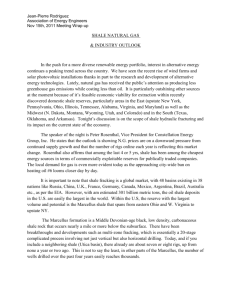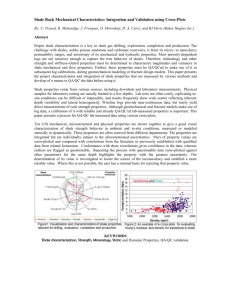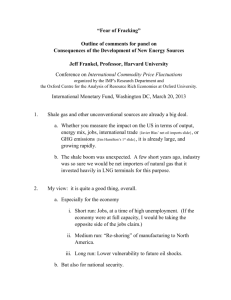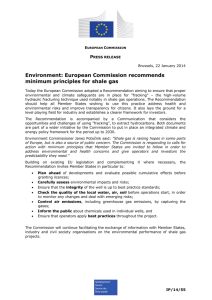Fracking 101
advertisement
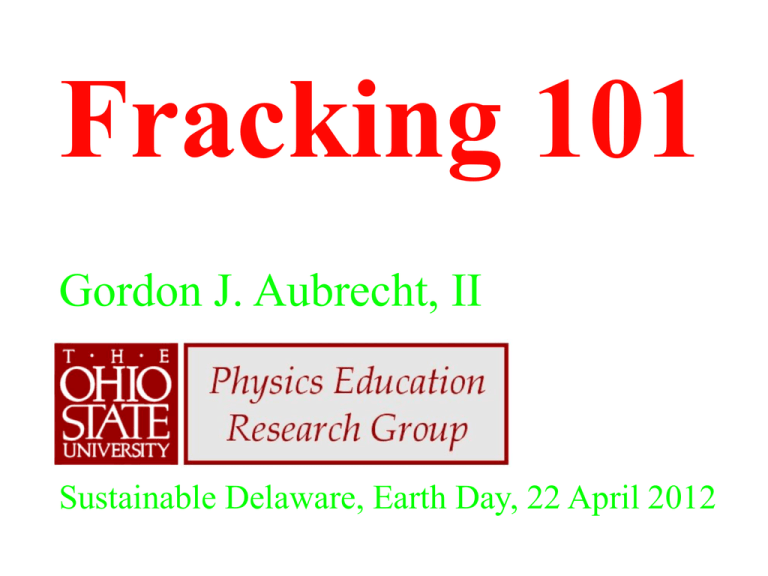
Fracking 101 Gordon J. Aubrecht, II Sustainable Delaware, Earth Day, 22 April 2012 What is fracking? This is short for “hydrofracturing.” This is an old technique for increasing oil production from worked-out oil wells, but a new technique for obtaining methane (natural gas). What is fracking? Hydraulic fracturing was first employed experimentally in 1947 in the Hugoton oilfield in Kansas. (Maybe it’s a “senior citizen” of oil recovery methods?) Fracking—hydraulic fracturing Water laced with chemicals is pumped down to fracture the shale and releases the gas, which can be pumped up. Fossil fuels Coal—essentially CH0.8 The most carbon per unit of energy. Oil—essentially CH2 Intermediate amount of carbon per unit of energy. Gas—CH4 The least carbon per unit of energy. This is surely preferable to the other fossil fuels for this reason. Ohio has considerable coal and considerable gas in shale formations. The coal is relatively “dirty”—high in contaminants such as sulfur. The gas is far below the surface in the Marcellus and Utica shales. 1821 – First U.S. commercial natural gas well in Fredonia, New York, produces gas from shale. … 1860s to 1920s – Natural gas, including gas produced from shallow, low pressure, fractured shales in the Appalachian and Illinois basins, is limited to use in cities close to producing fields. Early 1970s – Development of downhole motors, a key component of directional drilling technology, accelerates. Directional drilling capabilities continue to advance for the next three decades. Late 1970s and early 1980s – Fear that U.S. natural gas resources are dwindling prompts federally sponsored research to develop methods to estimate the volume of gas in “unconventional natural gas reservoirs” such as gas shales, tight sandstones and coal seams, and to improve ways to extract the gas from such rocks. Deeper buried shales, such as the Barnett in Texas and Marcellus in Pennsylvania, are known but believed to have essentially zero permeability and thus are not considered economic. 1980s to early 1990s – Mitchell Energy combines larger fracture designs, rigorous reservoir characterization, horizontal drilling, and lower cost approaches to hydraulic fracturing to make the Barnett Shale economic. 2003 to 2004 – Gas production from the Barnett Shale play overtakes the level of shallow shale gas production from historic shale plays like the Appalachian Ohio Shale and Michigan Basin Antrim plays. About 2 billion cubic feet (Bcf) of gas per day are produced from U.S. shales. 2005 to 2010 – Gas production from Barnett Shale grows to about 5 Bcf per day. Development of other major shale plays begins in other major basins. 2010 – The Marcellus shale underlies a significant portion of the mid-Atlantic/NE region—close to East Coast metropolitan natural gas demand centers—and is thought to contain nearly half of the technically recoverable shale gas resource. About 360–415 million years ago, during the Devonian Period of Earth’s history, the thick shales from which we are now producing natural gas were being deposited as fine silt and clay particles at the bottom of relatively enclosed bodies of water. At roughly the same time, primitive plants were forming forests on land and the first amphibians were making an appearance. Some of the methane that formed from the organic matter buried with the sediments escaped into sandy rock layers adjacent to the shales, forming conventional accumulations of natural gas which were relatively easy to extract. But some of it remained locked in the tight, low permeability shale layers. More detail on the Marcellus shale Vice President Cheney’s gift Section 322 of PL 109-58 amended the Safe Drinking Water Act to exempt all fracturing fluids except diesel from EPA regulations. The industry claim is that with this technology, there is no groundwater contamination. “The increase over the nation’s midsection has gotten steeper since 2009, due to more quakes in a variety of oil and gas production areas, including some in Arkansas and Oklahoma, the researchers say. “Fracking at fault? Probably not “It’s not clear how the earthquake rates might be related to oil and gas production, the study authors said. They note that others have linked earthquakes to injecting huge amounts of leftover wastewater deep into the earth.” Today’s Plain Dealer




